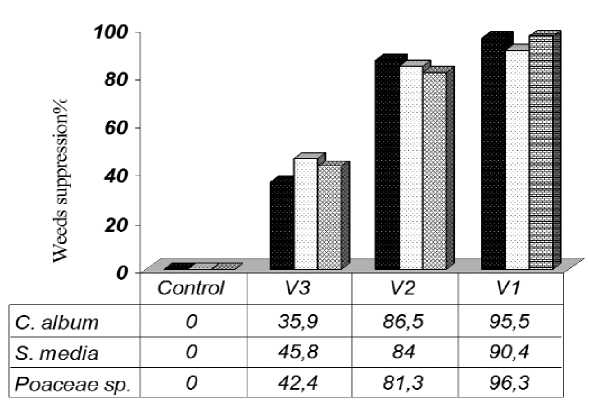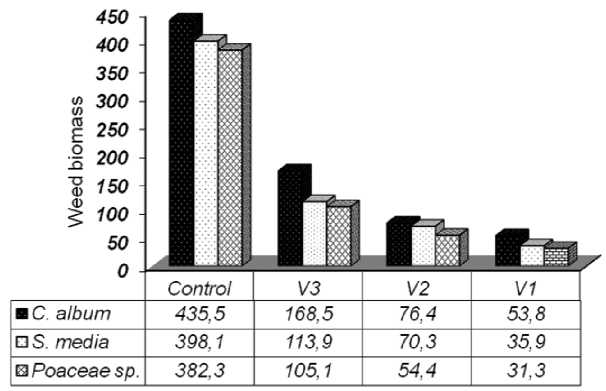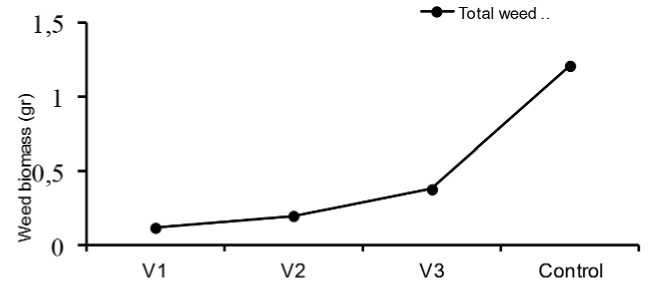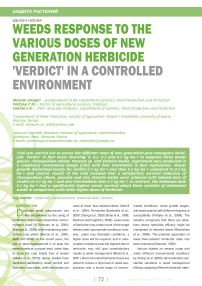Weeds response to the various doses of new generation herbicide ''Verdict'' In a controlled environment
Автор: Meisam Zargar , Polityko P.M., Pakina E.N.
Журнал: Овощи России @vegetables
Рубрика: Защита растений
Статья в выпуске: 1 (22), 2014 года.
Бесплатный доступ
Trial was carried out to survey the different rates of new generation post-emergence herbicide 'Verdict' in four levels involving: 0, 0.2, 0.3 and 0.5 kg ha-1 to suppress three weeds species; Chenopodium album, Poaceae sp. and Stelaria media. Experiment was conducted in a completely randomized design [CRD] with four treatments in four replications. Weeds growth diminished mostly for verdict 0.5 kg ha-1 and then 0.3 kg ha-1 compared to 0.2 kg ha-1 and control, results of the trial revealed that a satisfactory survival reduction of Chenopodium album, poaceae and also Stelaria media were achieved with labeled-dose of verdict as 0.5 kg ha-1 and also intermediate dose 0.3 kg ha-1. In contrast, the minimum dose 0.2 kg ha-1 had a significantly highest weeds survival about three varieties of mentioned weeds in comparison with other higher doses of herbicide.
Herbicide, weed survivai, reduced dose, verdict
Короткий адрес: https://sciup.org/14025222
IDR: 14025222 | УДК: 632.51:632.954
Текст научной статьи Weeds response to the various doses of new generation herbicide ''Verdict'' In a controlled environment
Desirable weed suppression can often be achieved by the using of herbicides at the lower doses than recommended ones (O'Donovan et al. 2004; Zhang et al., 2000) while maintaining satisfactory crop yields (Barros et al., 2005, 2007 and 2008). In the recent years, the aim of weed management is to keep the weed density at a proper level, rather than to keep the crop totally free of weeds (Nikitin et al., 2010). Some studies have illustrated satisfactory weed control and favorable crop yields, while herbicides are used at lower than labeled-doses (Hamill et al., 2004; Fernandez-Quintanilla et al., 2000; Zhang et al., 2000; Brian et al., 1999; Bostrom and Fogelfors, 2002). Lower dose of herbicide may control most of the target weeds under appropriate conditions; however, under less desirable conditions, a higher dose will be required, and in unfavorable conditions even the highest rate of herbicide may still give unsatisfactory results in weed management (Medd et al. 2001). Recommended herbicide doses are opted to ensure a high level of weed suppression over a broad range of environ- mental conditions, weed growth stages, and weed species with different degrees of susceptibility (Polityko et al., 2008). The industry recognizes that there are situations where herbicide efficacy might be maintained at reduced doses (Blackshaw et al., 2006). The potential application of lower-than-labeled herbicide rates has been examined (Salonen, 1992).
Various studies on several crops and under different environmental conditions by Zhang et al (2000) demonstrated substantial variations in weed management efficacy applying different herbicide rates.
The same research indicated that weed control efficacy tended to be lower and varied more at reduced doses than recommended ones, but remained within the 60-100% range in over 90% of the cases. In more cases, weed control was over 70% at doses between 30% and 60% of the recommended dose (Zhang et al., 2000). The objective of the present study was to investigate suppressing weeds community with reducing verdict doses up to 0.2 kg ha-1. Experiment was carried out under controlled environment conditions with the aim of using Verdict for promoting crop-industry.
MATERIAL AND METHODS
Weed seeds collection and preparation. Chenopodium album, Stelaria media and Poaceae sp. seeds collected from
Table 1. Weed species and average density in the trial field in 2009-2011
|
Weeds species |
Weeds density (number/m1) |
|||
|
2009 |
2010 |
2011 |
Average |
|
|
Cirsium arvense L (Field Thistle) |
2 |
2.3 |
3 |
2.4 |
|
Sonchus arvensis L (Perennial Sow Thistle) |
1 |
1.1 |
0.7 |
1 |
|
Matriceria inodoraL (Scentless Camomile) |
8 |
5.7 |
9 |
7.6 |
|
Galium aparine L(Stickywilly) |
4 |
4 |
9 |
5.7 |
|
Stella ria media L( Chickweed) |
12 |
10.9 |
6 |
9.6 |
|
Chenopodium album L (Lambsquarters) |
4 |
8 |
0.6 |
4.2 |
|
Species of Fumaria (Earth Smoke) |
6 |
4.6 |
6 |
5.5 |
|
Thlospiarvense L (Field Penny Cress) |
1 |
1.7 |
9 |
4 |
|
Raphanus raphanistrum L (Wild Radish) |
0 |
2.3 |
9 |
3.8 |
|
Capsella bursa-pastoris L (Shepherd s Purse) |
4 |
2.3 |
3 |
3.1 |
|
Taraxacum officinale Wigg.(Common Dandelon) |
3 |
2.9 |
6 |
4 |
|
Glechoma hederacea L (Ground Ivy) |
0 |
1.7 |
0 |
0.6 |
|
Gnaphalium uliginosumL (Marsh Cudweed) |
8 |
9.8 |
0 |
5.3 |
|
Poaceae sp. |
2 |
8 |
0.6 |
3.5 |
|
Crepis tectorum L (Hawks Beard) |
0 |
1.7 |
0 |
0.6 |
|
Species of Polygonum (Knotgrass) |
2 |
2.9 |
0 |
2 |
|
Fallopio convolvulus (Climbing Buckweed) |
1 |
1.7 |
11.9 |
4.8 |
|
And others |
3 |
6.3 |
8.3 |
5.8 |
Hence, these weeds are chosen for our study subject, investigation of many years' field experiments show that Stelaria media has high density among weeds community in winter wheat fields.
Transfer the germinated seeds into pots . Eight germinated seeds from each weed species were sown 2 cm deep in 15 cm diameter and 20 cm depth pots filled with a mixture of silty loam soil texture (sand=15.5%, silt= 57.7%, clay= 26.8%), pH=7.5. The pots were irrigated every four days before chemical spray.
The experimental design was laid out in completely randomized design [CRD] with four treatments in four replications. Each replication was consisted of four pots and each pot was separately and randomly assigned with a treatment which was a new generation herbicide 'Verdict' [at four lev- els (0, 0.2, 0.3 and 0.5 kg ha-1)], also surfactant was not used for herbicide. The pots were kept in greenhouse at 25/16°C (±0.5°C) day/night temperatures.
Herbicide application . Weeds were sprayed at the three to four leaves stages after 5 weeks (in November 5) by using an overhead trolley sprayer. At the end of the experiments (30 days after spraying), density and dry weight of three species of weeds and also total weed biomass in each pot were recorded.
To calculate the weeds suppression percentage the following formula was used:
[Biological effectiveness of verdict % = (number of suppressed plants four weeks after spraying/Initial number of plants in each pot) x 100].
Statistical analysis . The data were analyzed statistically by an analysis of variance (ANOVA), using the general linear model procedure of SAS Institute (SAS Institute 2002). Duncan's multiple range test was used for the separation of the means when the F-test revealed an error probability of less than or equal to 5% (P < 0.05).
RESULT AND DISCUSION
Weed survival. The results showed that the weeds survival were significantly reduced 30 days after application compared with before treatment with herbicide. (P<0.01) (Table 2). The significant reduction was directly related to increasing the Institute of Agriculture «Nemchinovka» Moscow area, Odintsovskiy region, Russia country in 2012 July. In early October 2012 one gram seeds of each weed species were mixed and the seed mixtures were tested by placing seeds in Petri dishes between moistened filter paper at 24°C for 10 days in the light. The seeds were tested in Petri dishes to give a germination rate > 99% at 22°C. Chenopodium album and Stelaria media were chosen because they usually occupу the lowest level in wheat field and in wet conditions it is very difficult to harvest, because of mentioned weeds species.

Figure 1. Effect of different doses of Verdict on reducing weeds. (V3, V2 and V1 are verdict 0.2, 0.3 and 0.5 kg ha-1 respectively)
Table 1. Weed species and average density in the trial field in 2009-2011
Significant of F ratio
|
Source |
df |
Weeds suppression |
Dry weight |
|||||
|
C. album |
S. media |
Poaceae sp. |
||||||
|
C. album |
S. media |
Poaceae sp. |
Total |
|||||
|
Treatment (verdict doses) |
3 |
8011.5** |
6936.6** |
7433.3** |
122721** |
10956.2** |
105369** |
1.01** |
|
Error |
12 |
30.8 |
60.7 |
59.4 |
185.8 |
167.6 |
121.6 |
0.00 |
|
Total |
15 |
|||||||
|
CV(%) |
12.1 |
17.3 |
17.1 |
7.4 |
8.3 |
7.6 |
5.2 |
|
herbicide doses. In the most cases, with increasing doses of Verdict up to a maximum dose of herbicides weeds were reduced to less than 10 percent (Figure 1).
Weeds percentage reduced mainly for Verdict 0.5 kg ha-1 and then 0.3 kg ha-1 compared to 0.2 kg ha-1 and control (Figure 1). Furthermore, results of the trial showed that a satisfactory survival reduction of Chenopodium album, Poaceae sp., and Stelaria media were obtained with labeled dose of herbicide as 0.5 kg ha-1 and also intermediate dose 0.3 kg ha-1. Significantly highest amount of three varieties of weeds was observed at the minimum dose of Verdict (0.2 kg ha-1).
Despite on the fact that the best weed suppression was achieved with the highest Verdict dose, the intermediate concentration of herbicide 0.3 kg ha-1 also provided desirable result in all studied weeds varieties (Figure 1). Modern weed science also emphasizes the ecological approach based on keeping weed densities below threshold levels rather than its eradication (Barroso et al., 2009). Numerous herbicide molecules at lower than-recommended doses are effective enough to provide satisfactory weed suppression without sacrificing yields and increasing weed infestation in the following years (Barros et al., 2007). Reduced herbicide doses seem to offer a promising tool for decreasing herbicide usage across the globe.
Ns and ** are non – significant and significant at 1% probability level, respectively.
As no high significant difference found between two concentrations of herbicides 0.5 and 0.3 kg ha-1 used in this study we conclude that Verdict with concentration of 0.3 kg ha-1 can be considered as candidate herbicide dose for reducing weeds with minimum unfavorable environmental impacts. In a few studies, using labeled doses achieved a weed suppression only on 20-40%, whereas a weed control efficacy of 70% and higher was obtained with herbicide concentrations as low as 20% of the label doses. The same study indicated that weed suppression efficacy tended to be lower and varied more at reduced doses than labeled ones; weed control was over 70% at doses between 30% and 60% of the label recommendation (Zhang et al., 2000). In addition, other studies have determined satisfactory weed control and acceptable crop yields, when herbicides are used at lower than labeled concentrations (Bostro"m and Fogelfors, 2002; Hamill et al., 2004). It seems that herbicides at reduced concentration are often sufficient to manage a weed at below the threshold levels. Below-labeled herbicide doses have proven to be an effective way of reducing herbicide input in cropping systems.

Figure 2. Effect of different doses of Verdict on reducing weeds biomass (mg). (V3, V2 and V1 are verdict 0.2, 0.3 and 0.5 kg ha-1 respectively)
Further field validation of these findings is required for field application of the herbicides.
Dry weight . The results of this study showed that the treatment had significant effect on dry weight of Stelaria media, Chenopodium album, Poaceae sp. and total weeds biomass (p <0.01; Table 2).
The highest weed control efficacy can be achieved by application of two concentrations 0.5 and 0.3 kg ha-1. No significant difference was found in the efficacy of weed control between two concentrations of the applied herbicides (Figure 2, 3).
Despite the lowest weeds dry weight was achieved with Verdict 0.5 kg ha -1 but it can be possible to suggest intermediate Verdict dose 0.3 kg ha-1 as desirable herbicide concentration on weeds control (Figure 2). Also, it was confirmed that the different concentrations of Verdict significantly affects on total weeds dry weights; increasing of the Verdict doses from 0.2 to 0.5 kg ha-1 effectively reduced the total weeds biomass (Figure 3). Significant weed control might be obtained with reduced concentrations of herbicides and also providing desirable weed control during critical periods (Barros et al., 2007; Bostrom and Fogelfors, 2002). There is no need to apply full herbicide concentration for weed suppression.
According to the result, we can suggest to reduce herbicide concentrations for improving of weed management systems.
This strategy can decrease environmental pollution, herbicide resistant weeds and ultimately achieve sustainable agricultural systems. Nevertheless, an acceptable weed suppression can be achieved by the using of herbicides at lower concentration than recommended ones (Zhang et al., 2000; O'Donovan et al., 2001) while maintaining satisfactory crop yields (Navarrete et al., 2000; Barros et al., 2008). Recently, the aim of weed management is to keep the weed populations at a favorable level, rather than to keep the crop totally free of weeds. Many studies have indicated satisfactory weed control and desirable crop yields, while herbicides are applied at lower than labeled rates (Bostr?m and Fogelfors, 2002; Hamill et al ., 2004).
CONCLUSION
Percentage of weeds was reduced by application of herbicide Verdict mainly in concentration 0.5 kg ha-1 and then 0.3 kg

Figure 3. Effect of different doses of Verdict on total weeds biomass (gr). (V3, V2 and V1 are verdict 0.2, 0.3 and 0.5 kg ha-1 respectively)
ha-1 compared to 0.2 kg ha-1 and control ('no application'). Trial data indicated that a satisfactory reduction of Chenopodium album, Poaceae sp., and Stelaria media were achieved with labeled dose of herbi- cide 0.5 kg ha-1 and also below-labeled dose 0.3 kg ha-1. In contrast, significantly highest amount of three varieties of weeds was observed at the minimum dose of Verdict (0.2 kg ha-1).
Список литературы Weeds response to the various doses of new generation herbicide ''Verdict'' In a controlled environment
- Barros J.F.C., Basch G., De Carvalho M. (2005). Effect of reduced doses of a post-emergence graminicide mixture to control Lolium rigidum G. in winter wheat under direct drilling in Mediterranean environment. Crop Protection, 24: 880-887.
- Barros J.F.C., Basch G., De Carvalho M. (2007). Effect of reduced doses of a post-emergence herbicide to control grass and broadleaf weeds in no-till wheat under Mediterranean conditions. Crop Protection, 26: 1538-1545.
- Barros J.F.C., Basch G., De Carvalho M. (2008). Effect of reduced doses of a post-emergence graminicide to control Avena sterilis L. and Lolium rigidum G. in no-till wheat under Mediterranean environment. Crop Protection, 27: 1031-1037.
- Barroso, J., D. Ruiz, C. Escribano, L. Barrios, and C. Fernandez Quintanilla. (2009). Comparison of three chemical controlstrategies for Avena sterlis ssp. ludoviciana. Crop Protection 28: 393-400.
- Blackshaw, R.E., O'Donovan, J.T., Harker, K.N., Clayton, G.W., Stugard, R.N. (2006). Reduced herbicide doses in field crops: A review. Weed Biol. Manag. 6, 10-17.
- Bostrom U., Fogelfors H. (2002). Response of weeds and crop yield to herbicide dose decision -support guidelines. Weed Science, 50: 186-195.
- Brian P., Wilson B.J., Wright K.J., Seavers G.P., Caseley J.C. (1999). Modelling the effect of crop and weed on herbicide efficacy in wheat. Weed Research, 39: 21-35.
- Fernandez-Quintanilla C., Barroso J., Recasens J., Sans X., Torner C., Sanchez M.J. Del Arc. (2000). Demography of Lolium rigidum in winter barley crops: analysis of recruitment, survival and reproduction. Weed Research, 40: 281-291.
- Hamill A.S., Weaver S.E., Sikkema P.H., Swanton C.J., Tardif F.J., Ferguson G.M. (2004). Benefits and risks of economic vs. efficacious approaches to weed management in corn and soybean. Weed Technology, 18: 723-732.
- Medd R.W., Van de Den J., Pickering D.I., Nordblom T. (2001). Determination of environment-specific dose-response relationships for clodinafop-propargyl on Avena spp.Weed Research, 41: 351-368.
- Navarrete L., Sanchez Del Arco M.J., Gonzales P.R., Taberner A., Tievas M.A. (2000). Curvas de dosis respuesta para avena loca y vallico en cultivos de cebada de invierno. XIX Reunion Anual del Grupo de Trabajo Malas Hierbas y Herbicidas, Oviedo. pp. 50-53. (In Spanish).
- Nikitin N.V., Spiridinov Y.J. and Shestakov V.G. (2010). Scientific and practical aspects of herbicide application technologies in modern crop production. Publishing City, Moscow. 189 pp.
- O'Donovan J.T.K., Harker N., Clayton G.W., Newman J.C., Robinson D., Hall L.M. (2001). Barley seeding rate influences the effects of variable herbicide rates on wild oat. Weed Science, 49: 746-754.
- Polityko P.M., Parigina M.N., Mazurova A.M., Volpe A.A. and Prokopenko A.G. (2008). Biological, economic, industrial and energetic effectiveness of winter wheat cultivation. Scientific conference «Aspects of selection and technology of crop cultivation». 324-332.
- Salonen, J., (1992). Efficacy of reduced herbicide doses in spring cereals of different competitive ability. Weed Res. 32, 483-491.
- Zhang J.S., Weaver E., Hamill A.S. (2000). Risks and reliability of using herbicides at below-labeled doses. Weed Technology, 14: 106-115.


